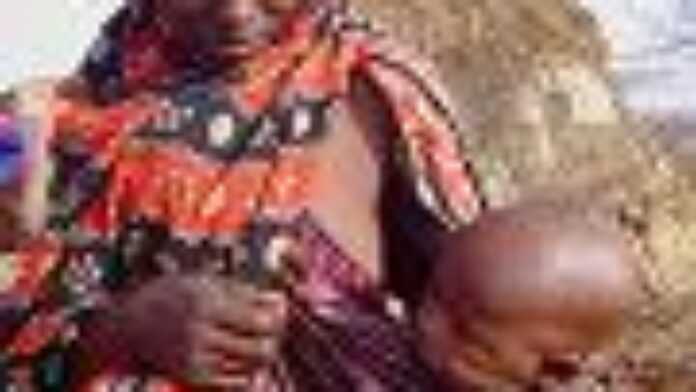
The rains have started falling in northeastern Kenya, but this alone is unlikely to immediately resolve the food problems facing the mainly nomadic families in the semi-arid region, aid workers said.
“The rains may be there but that doesn’t translate into improved milk availability, food access and food security,” Assumpte Ndumi, a nutrition coordinator for Save the Children, said.
Locals who have endured a long drought say their livelihoods are threatened and some cannot afford to feed their families.
“The price for 1kg of [maize meal] is now 90Ksh [US$1.45],” Mohammed Yakub, an assistant chief in El Ram, a remote village 80km from the town of El Wak in the drought-prone Eastern Mandera district. “It used to be 50Ksh [80 cents]. How can I feed my eight children?”
The problem is particularly acute for the pastoralist families, according to James Odour, drought management coordinator at Arid Lands Resource Management Programme in Nairobi.
“The terms of trade for the pastoralists will deteriorate because they will need to sell a lot of livestock to buy small amounts of cereals,” he explained.
Following assessments in March, the UN World Food Programme (WFP) estimated that 180,000 people would require emergency food aid in Kenya’s drought-affected areas after poor short rains at the end of 2007.
However, a drought on the scale of 2004-2005 has been averted by the onset of the long rains. Even so, a study by Save the Children in March showed that one in four children in El Wak was malnourished, a figure 50 percent higher than the emergency threshold.
Food prices
Food prices have more than doubled since January, Shakri Malim Mohammed, a food trader in El Wak noted, attributing the rise to transport problems associated with post-election violence in January and February, insecurity in Somalia (where a large proportion of food in Mandera is smuggled from) and the global food crisis.
“The wholesale price of rice was 1,500Ksh [$24] for 50kg in January,” he explained. “It has become so expensive – it now costs 3,600Ksh [$58]. People are buying much less than before.”
In addition to poor food security, Save the Children, for example, emphasises that milk production, an important part of the pastoralist diet, has been seriously reduced because of multiple issues associated with livestock health.
“The livestock have undergone a lot of stress with the droughts, floods and diseases,” Ndume told IRIN.
According to aid agencies in El Wak, a town that spans the Kenya-Somali border, large numbers of livestock died after severe droughts and poor rains in recent years. This has reduced the ability of nomadic pastoralists to support themselves and forced many to settle permanently in the vicinity of permanent water sources such as El Wak.
However, due to overgrazing, pasture around such permanent settlements quickly degrades. Consequently the pastoralists have had to depend on food aid throughout the dry season.
“Many people cannot afford food; but even if they could, no food is available,” Mohammed said. “Normally we can sell a litre of milk in the market for 50KSh [80 cents] but now the price of food has increased.
“Food is usually provided by COCOP [Consortium of Cooperative Partners]) but for the last two months there have been no distributions,” he added. “If we look at the worsening droughts every year, we don’t think our livestock and livelihood will be able to exist.”
Food for assets
According to Abdul Shakih, field coordinator for COCOP, the local NGO that is piloting the WFP “food-for-assets” programme, the local people have to develop a new lifestyle.
“With the increasing number of settlements and the reduction in the number of animals, these people can’t survive simply as nomadic pastoralists,” he said.
The food-for-assets initiative is being tried in the three Mandera districts as a government effort to move from aid and a potential dependency culture towards self-sufficiency.
“They started two months ago,” Shakih told IRIN. “They are building water pans which trap water like a reservoir. Since the rains fell the outcome has already been really successful.
“We are also piloting the construction of a 1.5km tunnel to divert water from the river Dawa for farmers. In the future we would like to diversify into building schools and whatever the communities prioritise.”
The scheme is aimed at increasing agricultural production in the region. While still in its infancy, officials hope the farmers will grow grass they can sell to the pastoralists.
“We are always looking [for] a solution at the other end of the spectrum before a crisis hits and these kinds of projects are an important way to achieve this,” Marcus Prior, spokesman for WFP, said.
Coping mechanisms
Mandera Member of Parliament Husein Ali urged the government and international aid agencies to help address the problem urgently to prevent loss of lives.
“Prices of maize, wheat flour, cooking fat and sugar have doubled in the past six months … every family is feeling the pain of the extra burden,” he said. “The government must act now and save thousands of families who cannot afford food … rising food prices must be arrested [and] relief food allocation increased to cover more families.
“The border [with Somalia] must be opened and cross-border business legalised; the government will earn revenue and at the same time make food available to many families.”
Zeinab Abdinoor from Habaswein in Wajir South echoed the plight of many food-insecure families in the region. “I only cook lunch and spare some food for supper for the two young children,” she said. “The older children have learnt to sleep without supper.”
IRIN

